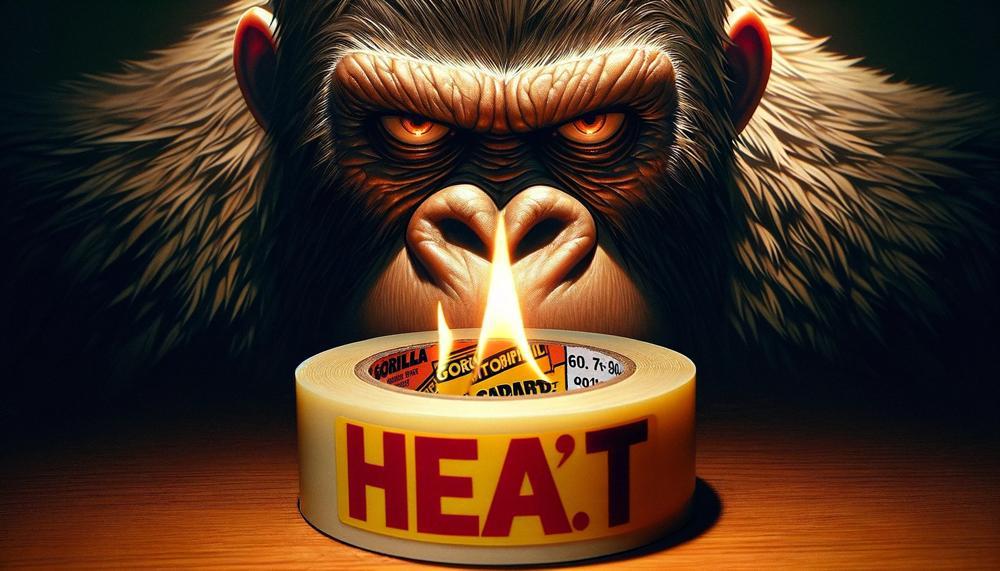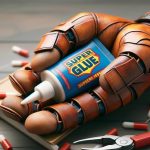If you’ve ever found yourself in a sticky situation where both the stakes and temperatures are high, you might have wondered just how much heat Gorilla Tape can handle before it loses its grip.
Whether it’s about patching up a broken tool handle or securing insulation in your attic, Gorilla Tape has become a go-to solution for fixes both inside and out. But when things get hot—really hot—how does this powerhouse tape hold up?
Today, we’re peeling back the layers on the thermal resilience of Gorilla Tape, because let’s face it, not all adhesives are created equal when it comes to standing the test of temperature.
So, can gorilla tape withstand heat?
Gorilla Tape is designed to withstand extreme weather conditions, including heat, cold, and moisture. It is made with a permanent, butyl adhesive and a weather resistant shell. It can resist drying, cracking, and peeling caused by sunlight, heat, cold, and moisture.
So, if you’re ready to turn up the heat and see if Gorilla Tape can take it, keep reading. We promise not to melt away your time with jargon or overused phrases—just straight, hot-off-the-press info to keep you sticking with the best.
Table of Contents
- 1 What is Gorilla Tape?
- 2 The Materials Used in Gorilla Tape Construction
- 3 Gorilla Tape’s Heat Resistance Claims
- 4 Factors That Affect the Heat Resistance of Gorilla Tape
- 5 Temperature Threshold of Gorilla Tape
- 6 Prolonged Exposure to High Temperatures and its Effects on Gorilla Tape
- 7 Testing Gorilla Tape Before Use in High-Temperature Environments
- 8 Specialized Tapes for Extreme Temperature Applications
- 9 Conclusion
What is Gorilla Tape?
Gorilla Tape is a brand of tape renowned for its formidable strength and tenacity. Crafted to outperform regular duct tape, this robust adhesive is a go-to for tasks demanding extra durability and grip.
Perfect for both indoor and outdoor applications, it boasts resistance to harsh UV rays and the elements, making it a steadfast ally in various repair scenarios.
Key Features
- Thickness: Gorilla Tape is notably thicker than its conventional counterparts, offering enhanced sticking power and reliability.
- Adhesive Strength: Its potent adhesive bonds fiercely to surfaces, especially the coarse and uneven, ensuring a tight seal.
- Versatility: Whether it’s mending furniture, sealing a window crack, or patching up a punctured tire, Gorilla Tape’s adaptability shines.
- Weather Resistance: Engineered to withstand unkind weather, this tape faces down sun, wind, rain, and temperature extremes without faltering.
The Materials Used in Gorilla Tape Construction
Gorilla Tape is renowned for its robustness and ability to tackle extreme temperatures. This resilience is credited to a combination of materials, each contributing to its heat tolerance:
- Reinforced Backing: The base of Gorilla Tape is a tough, tightly woven fabric, typically made from cotton or polyester, which provides an excellent balance of strength and flexibility. This fabric endures high temperatures without losing integrity.
- Special Adhesive: A unique adhesive blend adheres swiftly and firmly, maintaining a strong bond even when exposed to heat. It’s designed to be UV and heat resistant, ensuring longevity and reliability.
- Backing Layer: A protective layer, often crafted from durable plastics like polyethylene or polypropylene, shields the adhesive against environmental damage and contributes to the tape’s overall temperature resilience.
- Embedded Fibers: Within the adhesive are robust fibers, such as fiberglass or nylon, which bolster the tape’s strength and enhance its ability to handle heat without degradation.
Gorilla Tape’s Heat Resistance Claims
Gorilla Tape’s claim to fame in the realm of heat resistance is anchored in its robust and innovative design. Here’s how it stands up to sweltering conditions and distinguishes itself from the pack:
Material Mastery
At its core, Gorilla Tape is a tapestry of rugged materials, each contributing to its thermal fortitude.
The tape boasts a double-thick adhesive, robust against the searing heat, paired with a woven cloth backing that brings muscle and might to its overall structure.
Heat Threshold
Gorilla Tape doesn’t just tolerate warmth; it confronts high temperatures head-on. Crafted to perform up to a sizzling 200 degrees Fahrenheit, it’s leagues ahead of many competitors whose tapes wilt under such thermal pressure.
Bonding Brilliance
The secret sauce to Gorilla Tape’s adherence prowess lies in its adhesive’s molecular makeup. It forms a steadfast bond with surfaces, retaining flexibility and grip even when the thermometer climbs.
Endurance Expertise
It’s not a flash-in-the-pan performance—Gorilla Tape’s endurance in the face of prolonged exposure to heat is nothing short of remarkable.
It has been put through its paces in torturous temperatures and has emerged unscathed, its adhesion unyielded.
Versatile Vigilance
Beyond the blaze, Gorilla Tape is vigilant against the invasion of humidity and moisture. Its adhesive barrier is like a steadfast sentinel, ensuring the tape’s grip remains unbroken in the dampest of conditions.
Flame Retardancy
Adding to its impressive resume, Gorilla Tape shows a commendable resistance to flames. It’s not just about withstanding heat; it’s about repelling fire, securing its position as a safe bet in potentially fiery situations.
Factors That Affect the Heat Resistance of Gorilla Tape
The heat resistance of Gorilla Tape hinges on its unique material makeup. The interplay between the adhesive layer, fabric mesh, and polyethylene backing gives this tape its robustness against heat.
- Adhesive Layer: A specialized formula enables the tape to bear up to 200°F. This resilience ensures the tape maintains its gripping power and doesn’t deliquesce under sweltering conditions.
- Fabric Mesh: Woven fibers distribute heat evenly. This integration fortifies the tape, averting any focal melting or adhesive debilitation.
- Polyethylene Backing: This offers stability against heat distortion and guards the adhesive against external heat-related threats.
Influence on Tape’s Performance
The heat resistance of Gorilla Tape is paramount to its versatility. It thrives in high-temperature scenarios where other tapes crumble. Here’s the impact:
- Enduring Extreme Heat: Its capacity to handle intense heat expands its utility in environments like automotive repairs where lesser tapes would dissolve.
- Outdoor Viability: With a defense against the sun’s baking rays, Gorilla Tape is a sturdy pick for external repairs.
- Persistent Adhesion: The tape’s resistance to heat promises an enduring bond. Its adhesion doesn’t wane, ensuring lasting repairs even when the mercury rises.
Table of Main Factors and Impacts
| Factor | Role in Heat Resistance | Impact on Performance |
| Adhesive Layer | Handles up to 200°F without melting | Ensures reliable bonding in hot conditions |
| Fabric Mesh | Distributes heat to prevent localized damage | Adds structural integrity to withstand heat |
| Polyethylene Backing | Stays stable at high temperatures | Protects the adhesive and ensures durability |
Gorilla Tape’s design is a testament to its heat resistance, exhibiting a blend of fortitude and adaptability in scorching conditions.
Temperature Threshold of Gorilla Tape
Gorilla Tape boasts a resilient composition, tailored to thrive in challenging environments. Notably, it maintains its stickiness and grip under scorching conditions.
However, when the mercury hits approximately 140°F (60°C), the tape’s adhesive begins to falter, and beyond this point, its steadfastness is undermined.
Here’s a quick reference table for the temperature thresholds of Gorilla Tape:
| Temperature | Effect on Gorilla Tape |
|---|---|
| Up to 140°F (60°C) | Adhesive remains effective |
| Above 140°F (60°C) | Adhesive strength decreases |
So, while the tape is hardy up to a sizzling 200°F (93°C), its bonding might wane when temperatures ascend past 140°F.
Prolonged Exposure to High Temperatures and its Effects on Gorilla Tape
Gorilla Tape, known for its robustness, is indeed compromised when it bakes for too long under scorching conditions. Let’s cut to the chase – sustained heat softens the sticky stuff, reducing its grip. Here’s the nitty-gritty on how heat plays the villain with Gorilla Tape’s stickiness.
Heat makes the adhesive components in Gorilla Tape less viscous, leading to a weakened bond. The tape’s might fades as the temperature climbs, particularly past its comfort zone of 140°F (60°C).
If you’re planning to stick it where the sun sizzles, best reach for Gorilla’s High Heat Tape instead. It’s the tape that doesn’t throw in the towel when the mercury soars.
To illustrate, here’s a handy table that breaks down the effects of heat on Gorilla Tape:

| Temperature Range (°F) | Adhesive Performance | Best Use |
| Under 140°F | Optimal stickiness | General-purpose bonding |
| 140°F to 170°F | Reduced stickiness | Short-term or temporary fixes |
| Over 170°F | Significant loss of adhesive strength | Switch to Gorilla High Heat Tape |
Remember, when the thermometer pushes its limits, so does the tape. So, if you’ve got a hot spot that needs patching up, best opt for the tape that can take the heat.
Testing Gorilla Tape Before Use in High-Temperature Environments
Gorilla Tape boasts a formidable structure for withstanding heat. Its robust, thick fabric and potent adhesive set it apart from less resilient tapes such as duct or masking tape, which may falter under intense heat due to their thinner composition and milder adhesives.
Testing Gorilla Tape in High-Temperature Conditions
To accurately gauge Gorilla Tape’s heat endurance, consider these methods:
- Melting Point Examination: Gorilla Tape softens at 200°F (93°C), a threshold where it begins to lose its cohesive form. This melting point surpasses that of many alternatives.
- Flammability Testing: Deemed “non-flammable” by the CPSC, Gorilla Tape resists ignition far better than many competitors.
- Real-World Heat Exposure: Apply the tape to a surface and subject it to elevated temperatures, simulating practical scenarios to observe its adhesive persistence and physical resilience.
| Tape Type | Melting Point | Flammability |
| Gorilla Tape | 200°F (93°C) | Non-flammable |
| Duct Tape | Lower than Gorilla Tape | Varies |
| Masking Tape | Significantly lower than Gorilla Tape | Varies |
In essence, Gorilla Tape exhibits superior heat resistance, rendering it a stalwart for tasks involving high temperatures.
Specialized Tapes for Extreme Temperature Applications
Answer: Gorilla Tape is renowned for its resilience across a broad spectrum of temperatures, making it a stalwart companion for those in need of a robust adhesive solution. Let’s delve into the specifics of its temperature tolerance and juxtapose it with other specialized tapes.
Temperature Tolerance of Gorilla Tape:
Gorilla Tape thrives in severe cold as well as scorching heat. Its adhesive qualities remain steadfast from -40°F to 200°F (-40°C to 93°C), a testament to its well-rounded engineering for diverse environments.
Comparison with Other Tapes:
| Tape Type | Low Temperature Endurance | High Temperature Endurance | Strength and Durability |
|---|---|---|---|
| Gorilla Tape | -40°F (-40°C) | 200°F (93°C) | High |
| Duct Tape | Varies by brand | Up to 200°F (93°C) | Medium |
| Electrical Tape | Varies by brand | Up to 176°F (80°C) | Low to Medium |
| Teflon Tape (PTFE) | Varies by brand | Up to 500°F (260°C) | Low |
Duct tape, while a staple in many toolboxes, doesn’t quite match Gorilla Tape’s tenacity, particularly when the mercury soars. Electrical tape, designed for insulating and splicing cables, offers decent temperature resistance but doesn’t provide the same muscle as Gorilla Tape does.
Teflon tape, or PTFE, may outshine in high-temperature scenarios, but it’s not the brawny type when it comes to adhesion and strength.
Conclusion
It’s clear from our exploration of Gorilla Tape’s fiery qualities that this isn’t your typical glue. This tape is designed to resist temperatures ranging from -40°F to a blistering 200°F, so it really can survive the heat. Its unique blend of a double-thick adhesive layer, woven fabric mesh, and polyethylene backing—all of which contribute to its remarkable thermal endurance and versatility—makes it stand out in the adhesive industry.
Gorilla Tape’s incredible heat threshold means it holds firm when other tapes would be melting, whether you’re patching up a hot water line or fastening insulation in a humid attic. Its ability to withstand moisture and UV radiation enhances its all-weather performance, making it suitable for both indoor and outdoor usage.
Furthermore, Gorilla Tape’s resilience extends beyond its capacity to withstand elevated temperatures. It is a dependable option for locations where fire danger is an issue because of its flame retardant qualities, which provide an additional degree of protection. This tape exceeds its rivals in terms of durability and long-term adhesion. It doesn’t simply stick; it stays there.
In conclusion, Gorilla Tape is the ideal heavy-duty ally if you want a tape that will remain with you through thick and thin, as well as hot and hotter. This is because of its exceptional heat resistance.






